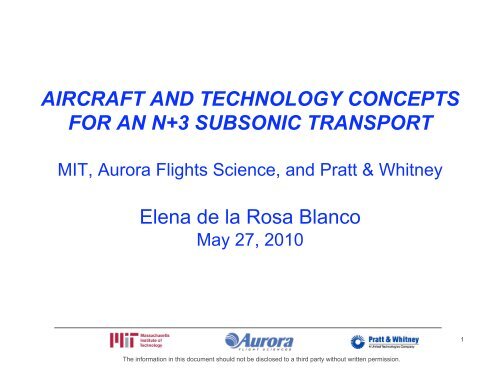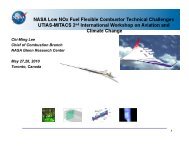AIRCRAFT AND TECHNOLOGY CONCEPTS FOR AN N+3 ...
AIRCRAFT AND TECHNOLOGY CONCEPTS FOR AN N+3 ...
AIRCRAFT AND TECHNOLOGY CONCEPTS FOR AN N+3 ...
Create successful ePaper yourself
Turn your PDF publications into a flip-book with our unique Google optimized e-Paper software.
<strong>AIRCRAFT</strong> <strong><strong>AN</strong>D</strong> <strong>TECHNOLOGY</strong> <strong>CONCEPTS</strong><br />
<strong>FOR</strong> <strong>AN</strong> <strong>N+3</strong> SUBSONIC TR<strong>AN</strong>SPORT<br />
MIT, Aurora Flights Science, and Pratt & Whitney<br />
Elena de la Rosa Blanco<br />
May 27, 2010<br />
The information in this document should not be disclosed to a third party without written permission.<br />
1
Message<br />
• Defined documented scenario and aircraft requirements<br />
• Created two conceptual aircraft: D (double-bubble) Series and H (Hybrid<br />
Wing Body) Series<br />
– D Series for domestic size meets fuel burn, LTO NOx, and balanced<br />
field length <strong>N+3</strong> goals, provides significant step change in noise<br />
– H Series for international size meets LTO NOx and balanced field<br />
length <strong>N+3</strong> goals<br />
– D Series aircraft configuration with current levels of technology can<br />
provide major benefits<br />
• Developed first-principles methodology to simultaneously optimize<br />
airframe, engine, and operations<br />
• Generated risk assessment and technology roadmaps for configurations<br />
and enabling technologies<br />
2
Project Enabled by University-Industry Collaboration<br />
• MIT<br />
– (GTL) Propulsion, noise, (ACDL) aircraft configurations, systems,<br />
(ICAT) air transportation, and (PARTNER) aircraft-environment<br />
interaction<br />
– Student engagement (education)<br />
• Aurora Flight Sciences<br />
– Aircraft components and subsystem technology; Aerostructures and<br />
manufacturing; System integration<br />
• Pratt & Whitney<br />
– Propulsion; System integration assessment<br />
• Collaboration and teaming<br />
– Assessment of fundamental limits on aircraft and engine performance<br />
– Seamless teaming within organizations <strong><strong>AN</strong>D</strong> between organizations<br />
3
NASA System Level Metrics<br />
…. technology for dramatically improving noise, emissions, performance<br />
*** Technology readiness level for key technologies = 4-6<br />
• Energy intensity metric for comparison of fuel burn<br />
** Additional gains may be possible through operational improvements<br />
• Add a climate impact metric for evaluation of the aircraft<br />
performance<br />
* Concepts that enable optimal use of runways at multiple airports within<br />
the metropolitan area<br />
– Global temperature change as a result of the emissions<br />
<strong>N+3</strong><br />
N+1<br />
N+2<br />
4
Three Major Results from <strong>N+3</strong> Program<br />
• Development and assessment of two aircraft configurations:<br />
– D Series for domestic size meets fuel burn, LTO NOx, and<br />
balanced field length <strong>N+3</strong> goals, provides significant step change<br />
in noise<br />
– H Series for international size meets LTO NOx and balanced<br />
field length <strong>N+3</strong> goals<br />
• Comparison of D Series and H Series for different missions<br />
(domestic and international)<br />
• Trade study identification of D Series benefits from configuration vs.<br />
advanced technologies<br />
5
Two Scenario-Driven Configurations<br />
Double-Bubble (D series):<br />
modified tube and wing with lifting body<br />
Baseline: B737-800<br />
Domestic size<br />
Field length<br />
Fuel burn<br />
(kJ/kg-km)<br />
LTO NOx<br />
100% of <strong>N+3</strong> goal<br />
Noise<br />
Field length<br />
Hybrid Wing Body (H series)<br />
Fuel burn<br />
(kJ/kg-km)<br />
LTO NOx<br />
Baseline: B777-200LR<br />
International size<br />
100% of <strong>N+3</strong> goal<br />
Noise<br />
6
D and H Series Fuel Burn for Different Missions<br />
Baseline<br />
H Series<br />
D Series<br />
<strong>N+3</strong> Goal<br />
Domestic International<br />
• D Series has better performance than H Series for missions examined<br />
• H Series performance improves at international size<br />
7
Fuel Burn Baselines and Results<br />
PFEI for 50 Best Existing Aircraft within Global<br />
Fleet Computed using Piano-X software<br />
D8.5<br />
H3.2<br />
8
D Series Configuration is a Key Innovation<br />
D8 configuration<br />
2035 Engine Technology<br />
Airframe materials/processes<br />
Natural laminar flow on bottom wing<br />
Airframe load reduction<br />
Approach operations<br />
LDI combustor<br />
% Fuel burn reduction relative to baseline<br />
% LT NOx reduction relative to CAEP6<br />
%0<br />
0<br />
%10<br />
-10<br />
%20<br />
-20<br />
%30<br />
-30<br />
%40<br />
-40<br />
%50<br />
Balanced Field Length for<br />
all designs = 5000 feet<br />
Fuel burn<br />
Noise<br />
LTO NOx<br />
-50<br />
EPNdB Noise reduction relative to Stage 4<br />
%60<br />
-60<br />
9
D8 Configurations: Design and Performance<br />
Field Length<br />
(feet)<br />
D8.1<br />
(Aluminum)<br />
Fuel Burn<br />
(kJ/kg-km)<br />
LTO NOx (g/kN)<br />
(% below CAEP 6)<br />
D8.5<br />
(Composite)<br />
Noise<br />
(EPNdB below Stage 4)<br />
10
D8 – Double Bubble Configuration with current<br />
technologies<br />
Payload: 180 PAX<br />
Range = 3000 nm<br />
• Double bubble lifting fuselage with<br />
pi-tail<br />
• Engines flush-mounted at aft<br />
fuselage with boundary layer<br />
ingestion; engine noise shielding<br />
and extended rearward liners<br />
• Reduced cruise Mach number with<br />
unswept wings and optimized<br />
cruise altitude<br />
• Eliminates slats<br />
• BFL = 5000 feet<br />
11
D8.5 Airframe Technology Overview<br />
Natural Laminar<br />
Flow on Wing<br />
Bottom<br />
Active Load<br />
Alleviation<br />
Health and<br />
Usage<br />
Monitoring<br />
Lifting Body<br />
with pi-tail<br />
Reduced<br />
Secondary<br />
Structure weight<br />
Faired<br />
Undercarriage<br />
Operations Modifications:<br />
- Reduced Cruise Mach:0.72 for D8.1 and 0.74 for D8.5<br />
- Optimized Cruise Altitude: 40,000 ft. for D8.1 and 45,000 ft. for D8.5<br />
- Descent angle of 4º<br />
- Approach Runway Displacement Threshold<br />
Advanced Structural<br />
Materials<br />
Boundary Layer<br />
Ingestion<br />
12
D8.5 Engine Technology Overview<br />
High Bypass Ratio<br />
Engines (BPR=20)<br />
with high efficiency<br />
small cores<br />
Advanced Engine<br />
Materials<br />
LDI Advanced<br />
Combustor<br />
Distortion<br />
Tolerant Fan<br />
Multi-segment rearward<br />
acoustic liners<br />
Variable Area Nozzle<br />
Tt4 Materials and<br />
advanced cooling<br />
13
Design Modification Sequence from B737-800 to D8.1<br />
and D8.5<br />
• Case 0: B737-800<br />
• Case 1: Optimized B737-800<br />
• Case 2: Fuselage replacement from tube+wing to double bubble<br />
• Case 3: Reduced cruise Mach number from 0.8 to 0.72<br />
• Case 4: Engines flush-mounted on top, rear fuselage<br />
• Case 5: 2010 Engine technology<br />
• Case 6: Slats elimination<br />
• Case 7 (D8.1): Balanced Field Length reduced from 8000 ft. to 5000 ft.<br />
• Case 8: Faired Undercarriage<br />
• Case 9: 2035 Engine technology<br />
• Case 10: Advanced Airframe materials and processes<br />
• Case 11: Natural laminar flow on bottom wing<br />
• Case 12: Airframe loads reduction<br />
• Case 13: Approach operations<br />
• Case 14 (D8.5): LDI combustor 14
Fuel burn evolution from B737-800 to D8.1 and D8.5<br />
B737-800 M=0.8<br />
100%<br />
B737-800 optimized<br />
96%<br />
Double-bubble fuselage<br />
77%<br />
Slow to M=0.72<br />
71%<br />
Eng rear<br />
55% 51% 50%<br />
2010 Eng.<br />
Tech,<br />
Slats remove<br />
D8.1<br />
BFL=5000 ft<br />
51%<br />
Faired undercarriage<br />
2035 engine tech.<br />
Airframe materials/processes<br />
NLF on bottom wing<br />
39% 33% 30%<br />
D8.5<br />
Load reduction<br />
29%<br />
15
LTO NOx evolution from B737-800 to D8.1 and D8.5<br />
63%<br />
B737-800 M=0.8<br />
57%<br />
B737-800 optimized<br />
47%<br />
Double-bubble fuselage<br />
44%<br />
Slow to M=0.72<br />
40%<br />
Eng rear<br />
2010 Engine Tech.<br />
38%<br />
Slats removal<br />
47%<br />
36%<br />
D8.1<br />
BFL=5000 ft<br />
2035 engine tech.<br />
44%<br />
Airframe materials/<br />
processes<br />
27% 27%<br />
NLF on bottom<br />
wing<br />
Load reduction<br />
D8.5<br />
LDI com.<br />
13%<br />
16
Noise evolution from B737-800 to D8.1 and D8.5<br />
0<br />
Stage 4 limit<br />
3<br />
B737-800 optimized<br />
1.9<br />
Double-bubble fuselage<br />
-3.5<br />
Slow to M=0.72<br />
-20.2<br />
Eng rear with 2010 tech.<br />
-25.7<br />
Extended rearward liners<br />
-31.9<br />
Slats removal<br />
D8.1<br />
-38<br />
BFL=5000 ft<br />
Faired undercarriage<br />
-38.7<br />
2035 engine tech.<br />
-48.1<br />
Airframe materials/processes<br />
NLF on bottom wing<br />
Load reduction<br />
D8.5<br />
-53.9 -54.6 -55.1 -60<br />
Approach ops.<br />
17
D8 BLI Approach<br />
Engines ingesting full upper<br />
surface boundary layer<br />
• Entire upper fuselage BL ingested<br />
• Exploits natural aft fuselage static pressure field<br />
– Fuselage's potential flow has local M = 0.6 at fan face<br />
– No additional required diffusion into fan<br />
– No generation of streamwise vorticity<br />
Contoured aft<br />
fuselage<br />
– Distortion is a smoothly stratified total pressure<br />
19
Improved Load/Unload Time and Airport Capacity<br />
• Climate change impact. D8 results on over 80% climate improvement from<br />
B737-800<br />
• Improved Load/Unload Time. D8.5 provides reduction in block time during<br />
load and unload and approach operations<br />
B737-800<br />
30 x 6 per aisle<br />
(35 min. load, unload)<br />
D8.5<br />
23 x 4 per aisle<br />
(20 min. load, unload)<br />
Flight time (hr) Trip time (hr) <br />
B737 D8.5 B737 D8.5 <br />
NYC‐LAX 4.81 5.29 5.98 5.96 (D8.5 is 1 minute faster than B737) <br />
NYC‐ORD 1.55 1.73 2.71 2.40 (D8.5 is 19 minutes faster than B737) <br />
BOS‐DCA 0.93 1.06 2.09 1.73 (D8.5 is 22 minutes faster than B737) <br />
• Airport capacity. D8 could allow for increased airport capacity due to wake<br />
vortex strength reduction<br />
20
First principle innovative aircraft design<br />
optimization tool (M. Drela)<br />
TASOPT (Transport Aircraft System OPTimization)<br />
• Modelled on a first-principles basis, NOT from correlations<br />
• Simultaneously optimizes airframe, engine, and operations parameters<br />
for given mission<br />
• Developed in modules so easily integrated with other tools<br />
• Generate required output files for detailed aeroelastic and<br />
aerodynamic analysis<br />
• Allows aircraft optimization with constraints on noise, balanced field<br />
length, and other environmental parameters<br />
21
Summary<br />
• Established documented scenario and aircraft requirements<br />
• Created two conceptual aircraft: D (double-bubble) Series and H (Hybrid<br />
Wing Body) Series<br />
– D Series for domestic size meets fuel burn, LTO NOx, and balanced<br />
field length <strong>N+3</strong> goals, provides significant step change in noise<br />
– H Series for international size meets LTO NOx and balanced field<br />
length goals<br />
– D Series aircraft configuration with current levels of technology can<br />
provide major benefits<br />
• First-principles methodology developed to simultaneously optimize<br />
airframe, engine, and operations<br />
• Generated risk assessment and technology roadmaps for configurations<br />
and enabling technologies<br />
22
Elena de la Rosa Blanco (edlrosab@mit.edu)<br />
Link to presentation: http://www.nasa.gov/topics/aeronautics/<br />
features/future_airplanes.html





